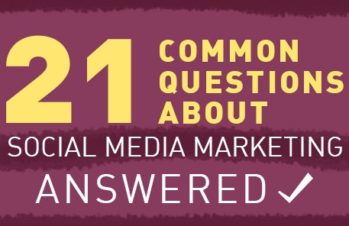The Facebook algorithm—like all social network algorithms—is an artificial intelligence software. Essentially, it can learn and rank items to appear in users’ feeds based on trends, interests, previous engagement, and similar metrics.
You may have noticed that your Facebook newsfeed doesn’t show content in chronological order. That’s because the algorithm evaluates every post based on the set of rules it has been given. Then, it scores the post to arrange it according to relevance or interest for each user. This is what Facebook calls the news feed ranking system, and it helps sort and present content to nearly three billion users.
Similar to the LinkedIn algorithm, Facebook’s algorithm scores a post based on metrics, like the type of post, frequency, format, etc. It rewards pages that post frequently, engage with their audience, create a community, and implement ad campaigns on the network.
Facebook Algorithm Ranking Factors
Like we mentioned above, Facebook’s algorithm prioritizes content that it sees as relevant to each individual, so its ranking system is based on evaluating posts and paid ads based on four ranking factors:
- The available posts to display
- Signals, telling Facebook what each post is
- Predications on how users will react to each post
- A score assigned to each piece of content based on all factors
Through this process, Facebook’s algorithm inventories all the available content that can be displayed. Then ranking signals, including:
- Relationships: how much a user engages with the poster and whether the post comes from a personal profile, business page, influencer, or news source
- Popularity: how other users are engaging with the post
- Content-Type: what kind of content the user interacts with the most, including time spent on posts and the format (video, link, image, carousel, story. etc.)
- Recency: when the content was posted (date, time, etc.)
With these qualifiers in mind, we’ve developed a five-step checklist on how to use Facebook for business to earn the favor of the AI overlords and help you hack the Facebook algorithm.
Five Easy Steps to Hack the Facebook Algorithm
Provide value.
Marketers are constantly talking about the need to provide value to their audience. Salespeople want to show leads the company’s unique value proposition. Everywhere you look, a guru is hounding content creators and brands to understand and deliver what their audience actually wants. Even Facebook itself says it prioritizes “meaningful and informative content.” But what does providing value actually look like?
By Facebook’s standards, it wants content that users will want to share with their loved ones and spend time reading or watching, based on past user behaviors. It also means content that users will find “new, interesting, and informative” will do well.
Additionally, as our CEO Shama Hyder says, adding value can also be a subtractive process. What friction can you remove from users’ experience with your content? These could be small changes—like adding subtitles to videos or adding captions that describe the images to make your content more accessible.
Your audience research should show what your audience segments will find meaningful and informative. Follow those breadcrumbs, and you’ll find your way to increased organic Facebook reach.
Be authentic and truthful.
It may seem obvious to say be authentic and truthful, but many companies abandon those principles, even just a hair, for the sake of social engagement. Sure, being connected to the latest trends and current news is important to show your audience that you are relevant and engaged in your industry and society. But most users are experienced at sniffing out fake news, misleading content, and sensationalized headlines.
It’s imperative to understand what your audience deems genuine and to deliver your content in a way that is both authentic to your brand and recognizable as trustworthy to your audience. To signal the algorithm that your content is “accurate, authentic content” (as Facebook puts it), ensure your headlines clearly describe what users can expect from your post—and don’t exaggerate or lie.
Optimize content and engage your audience.
Relationships and recency are half of the ranking factors contributing to Facebook’s algorithm. Knowing when your followers are on the platform allows you to optimize post time and date for better engagement in your organic reach. Using Facebook Marketing metrics, you can determine the best post time and use the post-scheduling tool in Facebook Publisher to have it published at the perfect time, no matter what.
But once it’s published, your brand needs to be there to engage with your audience. Respond to comments, like users’ shares, and be receptive to the feedback you get, positive or negative. (And remember that radio silence is feedback, too. The algorithm is telling you to step it up.)
Diversify post formats.
In February 2022, Facebook expanded its Reels feature from the initial U.S. launch to the worldwide userbase, noting that half of all time spent on Facebook and Instagram is spent watching videos. The social network said, “Reels is our fastest-growing content format by far.”
But that doesn’t mean every post needs to be video. Diversify your messaging into images, text, video, live streams, and more. Then, from each established message, create a piece of content from each established message in each format. Voilà. You have mixed-media content that supports your overall marketing goals with consistent brand messaging. And you’ve made the algorithm happy along the way.
Avoid the inclination to manipulate the algorithm.
Wait, what? Wasn’t this whole blog post about how to hack the Facebook algorithm? Isn’t hacking akin to manipulating? While we say these are tips to hack the algorithm, this is really education about how the algorithm works—and how you can get it to work in your favor, fair and square. (And who doesn’t want to reap the SEO benefits of “How to hack the Facebook algorithm”?)
So, no, we aren’t teaching you to hack the Facebook algorithm. In fact, Facebook strictly prohibits it. Manipulating the algorithm would be doing things like deliberately using clickbait headlines or artificially inflating engagement (by paying for likes or using bots, for example). Those are big no-nos, and—a bit like Big Brother—Facebook will catch you.
Despite the ever-evolving nature of social media algorithms, it is possible for brands to create meaningful, engaging Facebook posts that pleases the platform and its audience. Need some help nailing your Facebook content strategy? That’s what we’re here for. Reach out.







